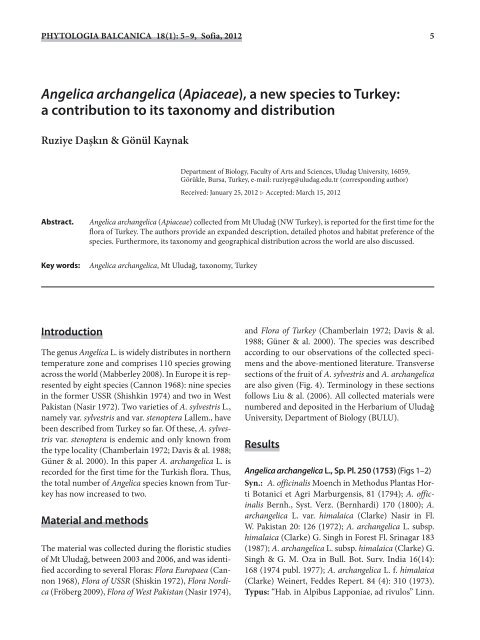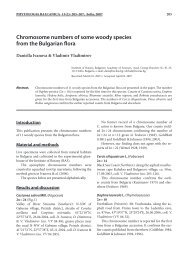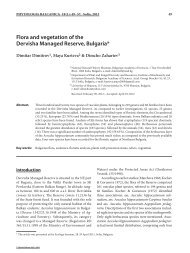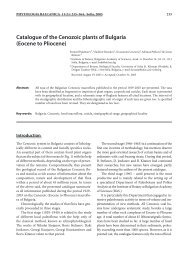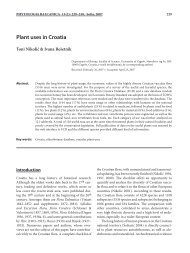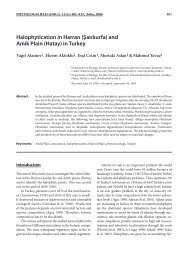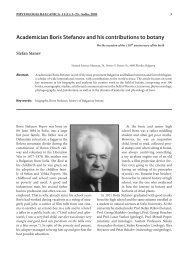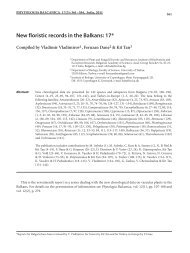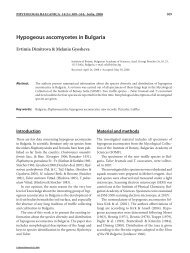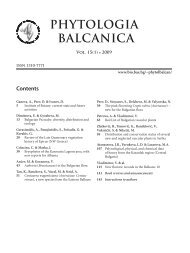Angelica archangelica (Apiaceae), a new species to ... - Bio.bas.bg
Angelica archangelica (Apiaceae), a new species to ... - Bio.bas.bg
Angelica archangelica (Apiaceae), a new species to ... - Bio.bas.bg
You also want an ePaper? Increase the reach of your titles
YUMPU automatically turns print PDFs into web optimized ePapers that Google loves.
PHYTOLOGIA BALCANICA 18 (1): 5 – 9, Sofia, 2012<br />
<strong>Angelica</strong> <strong>archangelica</strong> (<strong>Apiaceae</strong>), a <strong>new</strong> <strong>species</strong> <strong>to</strong> Turkey:<br />
a contribution <strong>to</strong> its taxonomy and distribution<br />
Ruziye Daşkın & Gönül Kaynak<br />
Department of <strong>Bio</strong>logy, Faculty of Arts and Sciences, Uludag University, 16059,<br />
Görükle, Bursa, Turkey, e-mail: ruziyeg@uludag.edu.tr (corresponding author)<br />
Received: January 25, 2012 � Accepted: March 15, 2012<br />
Abstract. <strong>Angelica</strong> <strong>archangelica</strong> (<strong>Apiaceae</strong>) collected from Mt Uludağ (NW Turkey), is reported for the first time for the<br />
flora of Turkey. The authors provide an expanded description, detailed pho<strong>to</strong>s and habitat preference of the<br />
<strong>species</strong>. Furthermore, its taxonomy and geographical distribution across the world are also discussed.<br />
Key words: <strong>Angelica</strong> <strong>archangelica</strong>, Mt Uludağ, taxonomy, Turkey<br />
Introduction<br />
The genus <strong>Angelica</strong> L. is widely distributes in northern<br />
temperature zone and comprises 110 <strong>species</strong> growing<br />
across the world (Mabberley 2008). In Europe it is represented<br />
by eight <strong>species</strong> (Cannon 1968): nine <strong>species</strong><br />
in the former USSR (Shishkin 1974) and two in West<br />
Pakistan (Nasir 1972). Two varieties of A. sylvestris L.,<br />
namely var. sylvestris and var. stenoptera Lallem., have<br />
been described from Turkey so far. Of these, A. sylvestris<br />
var. stenoptera is endemic and only known from<br />
the type locality (Chamberlain 1972; Davis & al. 1988;<br />
Güner & al. 2000). In this paper A. <strong>archangelica</strong> L. is<br />
recorded for the first time for the Turkish flora. Thus,<br />
the <strong>to</strong>tal number of <strong>Angelica</strong> <strong>species</strong> known from Turkey<br />
has now increased <strong>to</strong> two.<br />
Material and methods<br />
The material was collected during the floristic studies<br />
of Mt Uludağ, between 2003 and 2006, and was identified<br />
according <strong>to</strong> several Floras: Flora Europaea (Cannon<br />
1968), Flora of USSR (Shiskin 1972), Flora Nordica<br />
(Fröberg 2009), Flora of West Pakistan (Nasir 1974),<br />
and Flora of Turkey (Chamberlain 1972; Davis & al.<br />
1988; Güner & al. 2000). The <strong>species</strong> was described<br />
according <strong>to</strong> our observations of the collected specimens<br />
and the above-mentioned literature. Transverse<br />
sections of the fruit of A. sylvestris and A. <strong>archangelica</strong><br />
are also given (Fig. 4). Terminology in these sections<br />
follows Liu & al. (2006). All collected materials were<br />
numbered and deposited in the Herbarium of Uludağ<br />
University, Department of <strong>Bio</strong>logy (BULU).<br />
Results<br />
<strong>Angelica</strong> <strong>archangelica</strong> L., Sp. Pl. 250 (1753) (Figs 1–2)<br />
Syn.: A. officinalis Moench in Methodus Plantas Horti<br />
Botanici et Agri Marburgensis, 81 (1794); A. officinalis<br />
Bernh., Syst. Verz. (Bernhardi) 170 (1800); A.<br />
<strong>archangelica</strong> L. var. himalaica (Clarke) Nasir in Fl.<br />
W. Pakistan 20: 126 (1972); A. <strong>archangelica</strong> L. subsp.<br />
himalaica (Clarke) G. Singh in Forest Fl. Srinagar 183<br />
(1987); A. <strong>archangelica</strong> L. subsp. himalaica (Clarke) G.<br />
Singh & G. M. Oza in Bull. Bot. Surv. India 16(14):<br />
168 (1974 publ. 1977); A. <strong>archangelica</strong> L. f. himalaica<br />
(Clarke) Weinert, Feddes Repert. 84 (4): 310 (1973).<br />
Typus: “Hab. in Alpibus Lapponiae, ad rivulos” Linn.<br />
5
6 Daşkın, R. & Kaynak, G. • <strong>Angelica</strong> <strong>archangelica</strong>, a <strong>new</strong> <strong>species</strong> <strong>to</strong> Turkey<br />
Fig. 2. Basal leaf (A) and ultimate segment of leaf (B) of A. <strong>archangelica</strong><br />
(BULU 20389).<br />
Herb. 354.1 (LINN). Lec<strong>to</strong>type: sel. by Reduron, Nordic<br />
J. Bot. 22: 83 (2002).<br />
An erect perennial with pungent odour. Roots<br />
long, thick and fleshy. Stems up <strong>to</strong> 2 m, with ridges<br />
and grooves, hollow and tinged with purple, not glaucous.<br />
Basal leaves very large, 2-pinnate, glabrous. Primary<br />
leaflets 4–9 × 2–4.5 cm, angle <strong>to</strong> rachis 40–55°,<br />
ovate <strong>to</strong> elliptic, acutely serrate, acuminate; irregular<br />
in outline and incised, often distinctly decurrent<br />
on the rachis. Ultimate leaf segments 8.5–12 × 5.5–<br />
10 cm, with 3 acuminate <strong>to</strong> obtuse and distinctly decurrent<br />
lobes, sessile, usually doubly serrate, with<br />
acute <strong>to</strong> acuminate teeth; <strong>bas</strong>e attenuate <strong>to</strong> cordate;<br />
apical lobe 4.5–7.0 × 2.0–3.5 cm. Cauline leaves 2-pinnate,<br />
ca. 11 × 10 cm and with petioles strongly sheated<br />
at the <strong>bas</strong>e. Upper leaves reduced <strong>to</strong> inflated sheaths,<br />
Fig. 1. <strong>Angelica</strong> <strong>archangelica</strong><br />
L. A, General view<br />
in the natural habitat.<br />
B, Fruit. C, Inflorescence.<br />
Pho<strong>to</strong> G. Kaynak,<br />
BULU 28222).<br />
which enclose the developing umbels. Umbels globose,<br />
10–20 cm across. Peduncles 2–22 cm, s<strong>to</strong>ut, glabrous.<br />
Bracts absent. Umbellules 30–40, 30–70-flowered,<br />
1–3.5 cm diam. Pedicels 0.3–1.7 cm, papillose all<br />
over. Bracteoles 8–13, persistent, linear, 0.8–1 × 0.2–<br />
0.7 mm, glabrous or papillose. Sepals 0.2 mm. Petals<br />
1.5–2.0 × 1.0 mm (excluding the ca. 0.5 mm long<br />
acuminate and incurved tip), olive-green <strong>to</strong> cream,<br />
ovate, cordate at <strong>bas</strong>e. Filaments 2.0–4.0 mm; anthers<br />
0.8–0.9 mm. Fruits oblong, slightly dorsiventrally flattened,<br />
glabrous. Mericarps 6–9 × 3.0–4.5 mm (excluding<br />
lateral ridges); dorsal ridges prominent and acute,<br />
the lateral ones developed as 0.2–0.8 mm wide wings<br />
(marginal wings) measured from the lateral veins.<br />
Chromosome number. 2n = 2x = 22.<br />
Habitat. On damp rocks and at watersides, under<br />
mixed forest of Pinus nigra-Fagus orientalis, between<br />
1450–1700 m, in Mt Uludağ, Turkey.<br />
Phenology. Flowering in June, fruiting July–August.<br />
General distribution. N & NE Europe, Himalayas<br />
in India, Pakistan, Nepal, former USSR and NW Turkey.<br />
Specimens examined: (Europe) unspecified, (B,<br />
digital image!). (Turkey). A2 (A) Bursa: Uludağ Mt;<br />
Keles, above Pınarcık village, on damp rocks, 1450–<br />
1500 m, 2003.07.09, G. Kaynak, R. Daşkın & Ö. Yılmaz,<br />
BULU 17338; İnegöl, Kıranköy village <strong>to</strong> Kıran Plataeu,<br />
at watersides, 1700 m, 2004.07.20, G. Kaynak,<br />
R. Daşkın & Ö. Yılmaz, BULU 20389; above Pınarcık<br />
village <strong>to</strong> Dutçalık Locality, 7. km, on damp rocks,<br />
1450–1500 m, 2006.07.17, G. Kaynak, R. Daşkın & K.<br />
Daşkın, BULU 28222.
Phy<strong>to</strong>l. Balcan. 18(1) • Sofia • 2012<br />
Discussion<br />
There are no earlier records of <strong>Angelica</strong> <strong>archangelica</strong><br />
from Turkey before this study. A comparison between<br />
our findings and the accounts given in Flora Europaea<br />
(Cannon 1968), Flora Nordica (Fröberg 2009) and Flora<br />
of West Pakistan (Nasir 1972) was made (Table 1).<br />
As can be seen from the Table, the <strong>species</strong> shows a variation<br />
in the length of peduncles, pedicels, bracteoles,<br />
and petal colour, as well as in the features of umbel<br />
rays and fruit. The <strong>species</strong> is native <strong>to</strong> N and NE Europe,<br />
South Greenland, N and C. Siberia, the Himalayas<br />
in India, Pakistan, and Nepal (Fig. 3). A big gap<br />
exists between the European and Asian continents in<br />
the distribution of the <strong>species</strong>. The population recorded<br />
from Uludağ (NW Turkey) is important, because<br />
it supports a connection between the European and<br />
Himalayan populations. The northern part of Uludağ<br />
is similar <strong>to</strong> Europe in terms of habitat and ecological<br />
conditions. The fact that the Euro-Siberian elements<br />
are dominant and that some <strong>species</strong> originating from<br />
Europe are present in the mountain verify this opinion<br />
(Daşkın & al. 2006; Daşkın & al. 2007; Daşkın &<br />
Kaynak 2010a, b, 2011).<br />
The <strong>species</strong> is close <strong>to</strong> A. sylvestris but mainly differs<br />
in its more irregular and incised, acutely serrate<br />
and decurrent on rachis leaf lobes, distinctly decurrent<br />
and 3-lobed ultimate segments, greenish <strong>to</strong> cream<br />
or whitish flowers, and fruits with rather thick mericarps<br />
(Cannon 1968; Fröberg 2009). The genus <strong>Angelica</strong><br />
has fruits comprising two homomorphic mericarps<br />
that are laterally compressed and is one of the genera<br />
in the family <strong>Apiaceae</strong> that have fruits with marginal<br />
wings (Liu & al. 2006). Transverse sections of the fruit<br />
of A. sylvestris and A. <strong>archangelica</strong> show that the mericarps<br />
of A. <strong>archangelica</strong> are thicker, its marginal wings<br />
Table 1. A comparison of selected characters of <strong>Angelica</strong> <strong>archangelica</strong> in this study with different Floras.<br />
Characters This study Flora Europaea Flora Nordica Flora of W Pakistan<br />
Leaves 2-pinnate 2-pinnate <strong>to</strong> ternate 2-pinnate <strong>to</strong> ternate 2–3 pinnate<br />
Leaf lobes 4–9 × 2–4.5 cm<br />
ovate <strong>to</strong> elliptic<br />
Ultimate leaf segments 8.5–12 × 5.5–10 cm<br />
3-lobed, decurrent<br />
not indicated not indicated 4–15 × 2–3 cm<br />
lanceolate <strong>to</strong> ovate<br />
not indicated<br />
3-lobed, decurrent<br />
6.5–13 × 8–17 cm<br />
with shallow sinuses<br />
Peduncle length 2–22 cm not indicated 10–13 cm 8–15 cm<br />
not indicated<br />
with decurrent <strong>bas</strong>es<br />
Number of bracts 0 0–few 0–8 not indicated<br />
Umbel rays 30–40, glabrous numerous, puberulent 22–54, papillose 15–40, not indicated<br />
Pedicel length 3–17 mm not indicated 9–15 mm 5–8 mm<br />
Number of bracteoles<br />
Bracteole size<br />
Number of flowers/<br />
umbellule<br />
Petal colour<br />
Petal size<br />
(excl. petal tip length)<br />
Fruit shape<br />
Fruit size<br />
Dorsal ridges of fruit<br />
Lateral ridges of fruit<br />
8–13<br />
0.8–1 × 0.2–0.7 mm<br />
30–70<br />
olive-green <strong>to</strong> cream<br />
1.5–2 × 1 mm<br />
oblong<br />
6–9 × 3–4.5 mm<br />
prominent<br />
acute<br />
with 0.2–0.8 mm wide<br />
wings<br />
not indicated<br />
not indicated<br />
not indicated<br />
greenish-white <strong>to</strong> cream<br />
not indicated<br />
oblong <strong>to</strong> elliptic<br />
5–8 ×3.5–5 mm<br />
prominent or not<br />
acute <strong>to</strong> obtuse<br />
not indicated<br />
2–13<br />
2.5–18 × 0.2–15 mm<br />
34–68<br />
green-grey <strong>to</strong> olive or<br />
white <strong>to</strong> greenish-white<br />
1–1.9 ×0.7–1.4 mm<br />
broadly oblong<br />
or rectangular<br />
3–9 × 1.1–2.2 mm<br />
prominent or not<br />
not indicated<br />
with 0.2–0.9 mm wide<br />
wings<br />
not indicated<br />
not indicated<br />
numerous<br />
white<br />
not indicated<br />
oblong <strong>to</strong> sub-<br />
quadrate<br />
6–8 × 3–4 mm<br />
prominent<br />
not indicated<br />
not indicated<br />
7
8 Daşkın, R. & Kaynak, G. • <strong>Angelica</strong> <strong>archangelica</strong>, a <strong>new</strong> <strong>species</strong> <strong>to</strong> Turkey<br />
Fig. 3. Geographical distribution of A. <strong>archangelica</strong> L. across the<br />
world. N and NE Europe, South Greenland, N and C. Siberia ( ),<br />
NW Turkey ( ), India, Pakistan, and Nepal ( ).<br />
are wider and the number of valecular vitta on each<br />
mericarp exceed that of A. sylvestris (Fig. 4).<br />
<strong>Angelica</strong> <strong>archangelica</strong> is subdivided in<strong>to</strong> two sub<strong>species</strong><br />
in Flora Europaea (Cannon 1968), Flora Nordica<br />
(Fröberg 2009). <strong>Angelica</strong> <strong>archangelica</strong> subsp. <strong>archangelica</strong><br />
is distributed in the mountains and has long<br />
bracteoles and large fruits with acute ridges. On the<br />
contrary, A. <strong>archangelica</strong> subsp. lit<strong>to</strong>ralis (Wahlenb.)<br />
Thell. is distributed at seashore and has short bracteoles<br />
and small fruits with rounded ridges. A comprehensive<br />
investigation of the <strong>species</strong> taxonomy in<br />
Norway has indicated a correlation between habitat<br />
and fruit morphology in the southern, but not in the<br />
northern parts. Generally, the fruits are larger in subsp.<br />
<strong>archangelica</strong> than in subsp. lit<strong>to</strong>ralis. Furthermore,<br />
several characters, i.e. length/width ratio of the apical<br />
leaflet, number and size of bracteoles and petal colour,<br />
can be used in delimiting the two sub<strong>species</strong> (Cannon<br />
1968; Fröberg 2009). The <strong>species</strong> is known<br />
for the flora of W. Pakistan as A. angelica var.<br />
himalaica (Nasir 1972).<br />
According <strong>to</strong> Flora Nordica (Fröberg 2009),<br />
A. a. subsp. <strong>archangelica</strong> is sweetly fragrant in<br />
taste, with rather easily compressed, not glaucous<br />
stem and petioles, elongated apical leaflet<br />
(length/width ratio 1.5–2.7), 8–13, 4–18 × 0.3–<br />
1(–1.5) mm large bracteoles, flowers with<br />
green-grey <strong>to</strong> olive-green petals, and fruits with<br />
6–9 × 4–6 mm large mericarps. On the contrary,<br />
subsp. A. a. lit<strong>to</strong>ralis is sharp in taste, with a<br />
usually distinctly glaucous, hard stem and petioles,<br />
rounded apical leaflet (length/width ratio<br />
1.2–1.6), 2–12, 2.5–5 × 0.2–0.4 mm large bracteoles,<br />
flowers with white <strong>to</strong> greenish white petals,<br />
fruits with 5–6.5 × 3.5–4.5 mm large mericarps.<br />
Since A. <strong>archangelica</strong> has been cultivated<br />
for a long time, many intermediates occur between<br />
the two sub<strong>species</strong>. This makes difficult<br />
the taxonomy of the <strong>species</strong>. Therefore, our<br />
specimens can be classified as belonging <strong>to</strong> subsp.<br />
<strong>archangelica</strong>, according <strong>to</strong> the above-mentioned<br />
characters, but we assume that they are<br />
given at a <strong>species</strong> level in this paper.<br />
Fig. 4. Transverse sections of fruit of A. sylvestris, BULU<br />
26232 (A) and A. <strong>archangelica</strong>, BULU 28222 (B). co – comissure;<br />
cv – commissural vitta; en – endosperm; maw – marginal<br />
wings; vv – valecular vitta.
Phy<strong>to</strong>l. Balcan. 18(1) • Sofia • 2012<br />
As a result of this study, the <strong>to</strong>tal number of the <strong>Angelica</strong><br />
<strong>species</strong> recorded from Turkey has increased <strong>to</strong><br />
two. Distribution of these taxa in Turkey is shown in<br />
Fig. 5. The following key is offerred for the genus <strong>Angelica</strong><br />
in Turkey:<br />
1. Terminal leaf lobes coarsely dentate, usually simple<br />
and not decurrent; umbels rays puberulent; flowers<br />
pinkish-white ............................................................<br />
...................................................................... A. sylvestris<br />
References<br />
Cannon, J.F.M. 1968. <strong>Angelica</strong> L. – In: Tutin, T.G. & al. (eds), Flora<br />
Europaea. Vol. 2. pp. 357-358. Cambridge Univ. Press, Cambridge.<br />
Chamberlain, D.F. 1972. <strong>Angelica</strong> L. – In: Davis, P.H. (ed.), Flora<br />
of Turkey and the East Aegean Islands. Vol. 4. pp. 431-432.<br />
Edinburgh Univ. Press, Edinburgh.<br />
Daşkın, R. & Kaynak, G. 2010 a. Vascular flora of the Uludag Mt<br />
(Bursa, Turkey) I. – Phy<strong>to</strong>l. Balcan., 16(3): 367-384.<br />
Daşkın, R. & Kaynak, G. 2010 b. Vascular flora of the Uludag Mt<br />
(Bursa, Turkey) II. – Phy<strong>to</strong>l. Balcan., 16(3): 385-411.<br />
Daşkın, R. & Kaynak, G. 2011. Conservation status of five endemic<br />
<strong>species</strong> distributed in Northwest Turkey. – Phy<strong>to</strong>l. Balcan., 17(2):<br />
213-219.<br />
Daşkın, R., Yılmaz, Ö. & Kaynak, G. 2006. Presence of Cirsium<br />
erio phorum (L.) Scop. (Asteraceae) in Turkey. – Turk. J. Bot.,<br />
30(6): 461-465.<br />
Daşkın, R., Yılmaz, Ö. & Kaynak, G. 2007. A <strong>new</strong> record for the<br />
flora of Turkey: Dactylorhiza maculata (L.) Soó subsp. maculata<br />
(Orchidaceae). – U.U.J.<strong>Bio</strong>l. & Envirom. Sci. (JBES), 1-(1): 11-14.<br />
2 • Phy<strong>to</strong>l. Balcan. 18(1) • 2012<br />
1a. Basal leaves lanceolate <strong>to</strong> ovate, with usually serrate<br />
ultimate segments; fruit wing 1–1.5 mm wide ..............<br />
........................................................................ var. sylvestris<br />
1a * . Basal leaves ovate, with crenate ultimate segments,<br />
fruit wing 0.3–0.8 mm wide .................. var. stenoptera<br />
1 * . Terminal leaf lobes acutely serrate, 3-lobed and<br />
distinctly decurrent; umbels rays glabrous; flowers<br />
greenish <strong>to</strong> cream ......................... A. <strong>archangelica</strong><br />
Fig. 5. Distribution of genus <strong>Angelica</strong> in<br />
Turkey. A. sylvestris L. var. sylvestris ( ),<br />
A. sylvestris var. stenoptera Lallem. ( )<br />
and A. <strong>archangelica</strong> L. ( )<br />
Davis, P.H., Mill, R.R. & Tan, K. (eds). 1988. Flora of Turkey and the<br />
East Aegean Islands. Vol. 10. Edinburgh Univ. Press, Edinburgh.<br />
Güner, A., Özhatay, N., Ekim, T. & Başer, K.H.C. (eds). 2000.<br />
Flora of Turkey and the East Aegean Islands. Vol. 11. Edinburgh<br />
Univ. Press, Edinburgh.<br />
Fröberg, L. 2009. <strong>Angelica</strong> L. – In: Flora Nordica electronic version<br />
code 6 b. – http://www.floranordica.org/Review/-Review_public/<br />
accounts/<strong>Angelica</strong>.html (accessed 20.06.2009).<br />
Liu, M.R., Plunkett, G.M., Lowry, P.P. II, van Wyk, B.E. & Tilney,<br />
P.M. 2006. The taxonomic value of wing types in the order<br />
Apiales.– Amer. J. Bot., 93: 1357-1368.<br />
Mabberley, D.J. (ed.). 2008. Mabberley’s Plant-book. A portable dictionary<br />
of plants, their classification and uses. 3 rd edit. Cambridge<br />
Univ. Press, Cambridge.<br />
Nasir, E. 1972. <strong>Angelica</strong> L. – In: Nasir, E. & Ali, S.I. (eds), Flora<br />
of West Pakistan. Vol. 20, pp. 126. Univ. of Karachi, Pakistan.<br />
Shishkin, B.K. 1974. <strong>Angelica</strong> L. – In: Shishkin, B.K. (ed.), Flora of<br />
USSR. Vol. 17, pp. 11-33. Translated from Russian by the Israel<br />
Program Scientific Translations Ltd, Jerusalem.<br />
9


